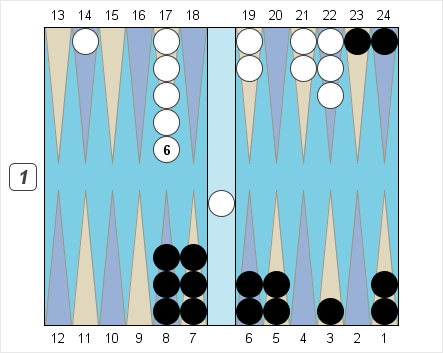In backgammon, the term ‘blitz’ refers to a position where one side is caught on the bar without an anchor, and the other side is trying to close him out before he can get in and organize his defenses. If the attacking side is successful, the result is often a gammon. If the defender can get in, he’ll usually save the gammon and may quickly take the advantage, especially if his opponent has become overextended. Blitzes are an important class of positions, and the aspiring player needs to understand them well.
Blitz positions fall into three main categories. The first is the familiar early game blitz, where one side (say, White) runs out or splits his back men and Black then throws a double, making a couple of inner points while sending White to the bar. When White dances, we’re in an early blitz situation. Most of these positions are doubles and takes, although there are exceptions, depending on how many builders are available to continue the blitz and how many vulnerable checkers the defender has.
Early blitzes can be mastered if you take the time to understand a relatively small number of reference positions. The best collection of examples is in Chapter 1 of Kit Woolsey’s Backgammon Encyclopedia Volume 1. Learn these and you’ll have the tools to reason out the many early blitz positions that you’ll actually see in your games.
The second class of blitz positions is what I call the middle game blitzes. As in the early blitzes, one side gets caught on the bar in an awkward moment while the opponent tries to close his board. Unlike the early blitzes, however, where the defender hasn’t had time to put together any kind of board, here the defender usually has some sort of position — perhaps three or four home board points, or even a prime of some sort. Now the position has to be evaluated not only in terms of the attacker’s assets, but also the defender’s assets, which may be substantial.
The final category is the late game blitz, where the defender has five or six home board points. These are also difficult and require careful study.
Middle game blitzes arise relatively frequently, are difficult to categorize or analyze, and the cube swings can be ferocious because at each roll there will be a few variations that will swing the advantage decisively to the opponent. Contrast this with holding games, back games, and priming games, which are relatively easy to categorize, and where decisive moments are often separated by long periods of straightforward plays.

Black – Pips 119 (+6)
A. Black on roll. Cube action?
Unlike the case in early game blitzes, however, White isn’t toothless. He’s got a three-point board of his own, Black still has to escape two checkers, and White’s extra blot isn’t immediately vulnerable. So how do we assess the actual strength of Black’s game?
Unfortunately, there is no easy answer. As advertised, these positions really are difficult, and simply counting points made or builders available just won’t do the job. The bots handle these positions well, but we humans make lots of mistakes (and big ones at that). Let’s look at this position and a couple of closely related ones, see what a bot can tell us, and then try to work our way backward to a more general understanding.
We’ll start with Position A, which is a big double and just a marginal take. Here are the results from an Extreme Gammon rollout:
Black’s equity if he doesn’t double: +0.66
Black’s equity after doubling: +0.99
Given the fact that White’s board is almost as strong as Black’s, that result might seem a little surprising. It looks like Black’s large number of builders, coupled with the fact that so many of his numbers actually make a fourth point, are decisive considerations. But before we jump to conclusions, let’s make a couple of modifications to White’s position and see what happens.

Black – Pips 119 (+10)
B. Black on roll. Cube action?
Black’s equity if he doesn’t double: +0.47
Black’s equity after doubling: +0.60
Doubling is still correct by a lot, but now the position is a monster take! That stacked 8-point cost White more than a third of a point in equity after taking a double.
Another slight weakness in White’s position is the open 5-point. What happens if we fix that?

Black – Pips 119 (=)
C. Black on roll. Cube action?
Black’s equity if he doesn’t double: +0.42
Black’s equity after doubling: +0.40
Wow. Compared to the original position, exchanging the 3-point for the 5-point improves White’s game by a whopping 2/3 of a point. Now doubling is a tiny mistake, but the position is actually closer to a beaver than a pass!
Our takeaway from these rollouts is a little unsatisfying but nonetheless important: in these supersharp positions, every feature of the position matters a lot. A stack here, a blot there, the exact configuration of points — everything plays a role in the decision making. For a few well-defined types of positions — particularly those where the defender has a real prime– we can produce some good rules. For most late game blitzes however, improvement is more a matter of looking at lots of different positions and gradually honing your instincts.





